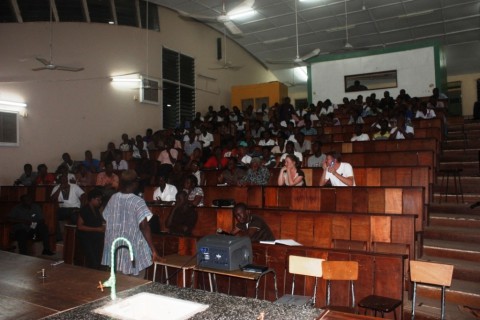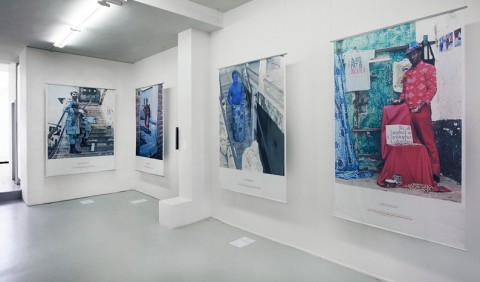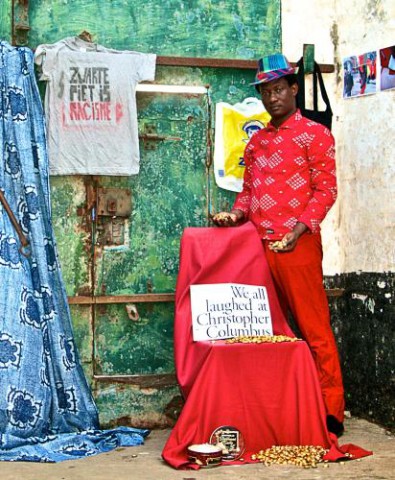On the final day of ‘Time, Trade & Travel’ Zachary Formwalt was interviewed by art historian and critic Sven Lütticken. After a brief introduction to Formwalt’s artistic practice and interests, a fragment of his newest video ‘A Projective Geometry’ was screened. The video was also part of the exhibition ‘Time, Trade & Travel’ in SMBA. The film testifies to Formwalt’s investigation of the history of a railway in present-day Ghana. The railway was built in the 19th century by Britain to connect Sekondi to the inland gold mine in Tarkwa as a facility to create a connection with the worldwide market.
More
Tag Archives: Ghana
Anthropologist Rhoda Woets not only wrote an essay for SMBA Newsletter #129 on the work of kari-kacha seid’ou, she also lectured modern and contemporary Ghanaian art on September 30. During this afternoon Woets discussed the work of several artists in relation to the complex definition(s) of contemporary Ghanaian art. The notion of contemporary art in Ghana is for instance related to institutions such as art schools and art galleries. Popular art, craftwork and weaving such as kente are usually not included in this category.
The Ghanaian government has a tradition in stimulating the arts. In 1952, five years before the nation’s independence from the United Kingdom, the College of Art in Kumasi was established. Resonating its colonial relations, the school was affiliated with art institutions in London, such as Slade and the Royal College. Ghana’s first president Kwame Nkrumah continued many of these international connections, as he took Western culture as exemplary in his mission to create an independent nation-state. In his vision modern art was a tool to construct identity; he argued that artists should express Ghanaian cultural history in their work. Many Ghanaians indeed relied on African traditions and symbols in order to express their identity. One example of this concept of ‘Sankofa’ is the ‘Accra Optimist Club’, a group of Ghanaian men who wore traditional cloths during colonial times.
More
Artist and writer Rikki Wemega-Kwawu wrote the sixth Project ‘1975’ ‘The Politics of Exclusion’. In this essay Wemega-Kwawu criticizes the fixation on Contemporary African Diaspora artists and the powerful position of curator Okwui Enwezor.
The Nigeria-born American curator Okwui Enwezor is often acknowledged as the representative of African art and artists. The first Johannesburg Biennale in 1997 and the Documenta XI in Kassel in 2002, are just two examples of the many exhibitions he organized. With these presentations and publications on the topic of African art, Enwezor played a crucial role in the production of a definition of contemporary African art. Wemega-Kwawu criticizes this definition in his Project ‘1975’ essay, as he signalizes an ‘Enwezor School’: a group of African artists, now living in the West, that are preferred and circulated well above their counterparts living in Africa. Wemega-Kwawu argues that Enwezor hereby defines contemporary African art by the artists’ experience of Diaspora: “as if nothing worthwhile is happening on the continent”. By the maintenance of this definition African artists living on the continent, are hindered to enter the international art scene. Click here to download Newsletter 125 ‘Tala Madani – The Jinn’ and to read Rikki Wemega-Kwawu’s essay ‘The Politics of Exclusion’.
Rikki Wemega-Kwawu (Ghana, 1959) lives and works as an artist and writer in Takordi, Ghana. He is alumnus of the Skowhegan School of Painting and Sculpture, Maine, U.S.A. In 2008, he was an Adjunct Professor in Art at the New York University – Accra, Ghana Campus, where he taught ‘postcolonial studio practices’.

Kari-kacha Seid'ou, art teacher, introduces Bouwhuis and Winking to the students of the College of Art / KNUST, Kumasi, Ghana.
In the week of October 27th, Jelle Bouwhuis and Kerstin Winking travelled to Ghana to meet with artists, as part of the exchange programme organised by SMBA and the Nubuke foundation in Accra. After their visit to Accra, they travelled to Elmina, Takoradi and Kumasi.
In Takoradi they met painter Rikki Wamega-Kwaku, who they requested to write a contribution for the next SMBA Newsletter. The College of Art of the Kwame Nkumrah University of Science & Technology invited Bouwhuis and Winking to visit Kumasi and to give a lecture on SMBA and contemporary curating. Furthermore several studio visits were organised to meet with several artists and art students.
Besides Ghana, Bouwhuis and Winking also travelled to Bamako (Mali), to attend the opening of the Bamako Encounters, the Biennale for African photography. One of the promising artists they met in Mali, Abdoulaye Konaté, might be part of a future exposition at SMBA.
Click here to read Bouwhuis’ review on the Bamako Encounters Biennale for Nafas Art Magazine.
Journalist Wim Bossema wrote a report about the art scene in Ghana for the Dutch newspaper De Volkskrant. Bossema met the internationally known and successful artist Kofi Setordji, and spoke to him about his new project in which he combines applied arts (and design) with fine arts. For this project, Setordji collaborated with the Nubuke Foundation. Furthermore Bossema discusses the paintings and installations of the Nigerian artist Akirash and the tradition of the highlife music genre in the 1960s and 1970s, which loses popularity due to the current curfew-order.
Click here to read Wim Bossema’s Dutch article ‘In Ghana ligt kunst op straat’.
The Nubuke Foundation’s Kofi Setordji and Odile Tevie visited the Stedelijk Museum Bureau Amsterdam, thanks to the support of the Prins Claus Fund. Stedelijk Museum Bureau Amsterdam is preparing a cultural exchange programme with Ghana, in which Netherlands-based artists and Ghana-based artists will meet and exchange knowledge, skills and experiences. The Nubuke Foundation plays an important role in the production of this Project 1975 exchange programme.
Click here to read more about the Nubuke Foundation and follow this Project 1975 blog to learn more about the cultural exchange programme.






